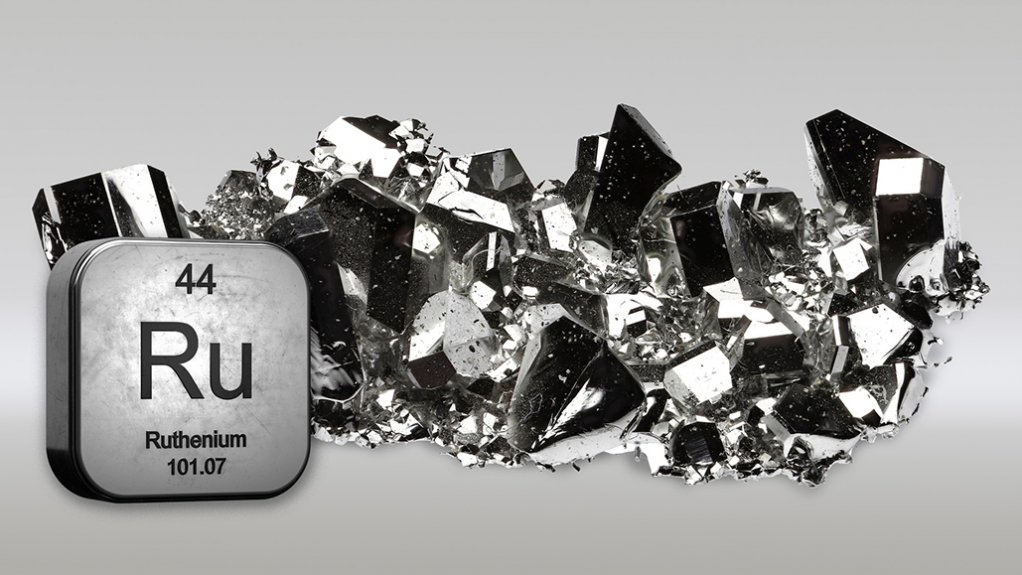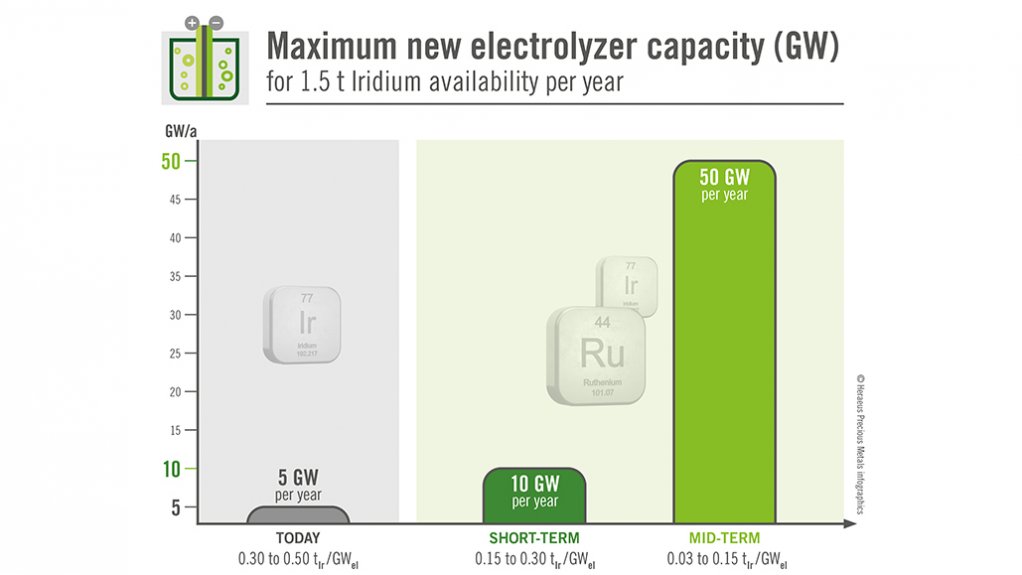JOHANNESBURG (miningweekly.com) – Green hydrogen generation received a major boost on Tuesday with the introduction of a far-reaching iridium-thrifting breakthrough by Germany’s Heraeus Precious Metals in collaboration with South Africa’s Sibanye-Stillwater.
The introduction of the new ruthenium-based catalyst for proton exchange membrane (PEM) water electrolysis crucially improves the sustainability of climate-critical hydrogen production by reducing material cost and the reliance on iridium, a scarce and expensive platinum group metal (PGM). Primary production of ruthenium, also a PGM, is 3.5 times that of iridium.
The unveiling of the quantum leap at the P2X conference in Frankfurt on Tuesday coincides with green hydrogen emerging as the indispensable element of a genuinely green and clean energy transition.
Moreover, the global Hydrogen Council has announced expectation of capacities of 175 gigawatts (GW) of the lightest element by 2030.
Hugely important for PGMs demand is that 40% of this future hydrogen capacity is poised to be brought about by PGMs-based PEM electrolysis, a technology that has up to now been constrained by iridium’s extremely limited supply.
With only about nine metric tons of iridium mined annually and widespread utilisation in various industries, supply bottlenecks were feared – until the latest breakthrough.
Currently, about 400 kg of iridium is required to build one GW of capacity. A reduction to less than 100 kg per GW is necessary to avoid supply bottlenecks. Heraeus' latest innovation, in collaboration with Sibanye-Stillwater, presents an 85% saving on iridium compared with an iridium oxide catalyst, alleviating the potential supply concerns.
Alongside iridium, ruthenium also catalyses the oxygen evolution reaction (OER), which is the critical stage in PEM electrolysis.
Ruthenium possesses superior catalytic activity to iridium but lacks stability in the challenging conditions of a PEM electrolyser stack.
The Heraeus concept solves this problem by combining both ruthenium and iridium oxide in a novel manner, enhancing stability while maintaining the increased catalytic activity provided by ruthenium.
This ruthenium-iridium oxide material class delivers an unprecedented activity boost. The catalyst can achieve up to 50 times higher mass activity than iridium oxide, and unlike ruthenium oxide alone, it remains stable in operational conditions.
Accelerated degradation tests confirmed its stability after 30 000 cycles, presenting activity loss significantly lower than for ruthenium oxide and on par with iridium oxide. These findings were verified by Mattiq, a startup based in Chicago, in the US, which combined industry expertise in chemistry and materials science and performed high throughput screening experiments for the development project.
By including ruthenium, Heraeus not only helps mitigate potential supply bottlenecks but also brings significant commercial benefits. By implementing this breakthrough, a significant 90% reduction in capital expenditure on material costs can be achieved, ensuring hydrogen production becomes more economically feasible and efficient.
“The dramatic reduction in capital expenditure needed per GW enabled by our new ruthenium-based catalyst not only addresses the iridium supply problem but also makes economic sense. It is solutions like these that will champion the necessary scale-up of the hydrogen industry, bringing us closer to achieving our global green energy goals,” Heraeus Precious Metals executive VP new business development Dr Philipp Walter stated in a media release to Mining Weekly.
Sibanye-Stillwater CEO Neal Froneman added: “As the largest producer of primary iridium globally, we firmly believe that sustainable demand of these metals, with supply in mind, is beneficial for the entire industry. The commendable progress achieved by Heraeus in their work to date is encouraging, and we highly value our partnership in this endeavor.”
In its product portfolio for the hydrogen economy, Heraeus already offers another iridium-saving catalyst based on iridium oxide on a carrier.
“We recognise that different operational settings may require different solutions; one catalyst may perform better under unique conditions, while another catalyst could be more suitable under other operation boundaries,” Heraeus Precious Metals R&D hydrogen systems head Christian Gebauer explained.
“The beauty of these two catalysts is their potential to further reduce the iridium content in the application. Our long-term outlook is to develop solutions that ultimately reduce iridium content to a mere 15 kg per GW. These advancements will open the doors for hyperscaling beyond 2030 and represent a significant stride in enabling a sustainable hydrogen industry and strengthening the future of green energy,” Gebauer highlighted.
EMAIL THIS ARTICLE SAVE THIS ARTICLE ARTICLE ENQUIRY
To subscribe email subscriptions@creamermedia.co.za or click here
To advertise email advertising@creamermedia.co.za or click here













